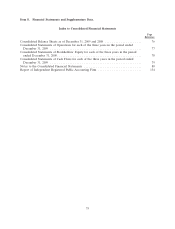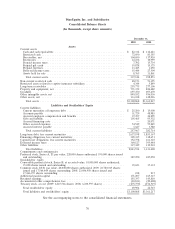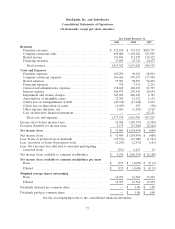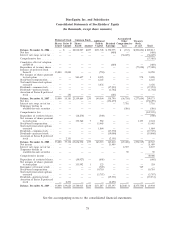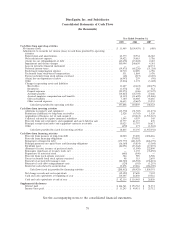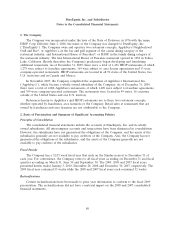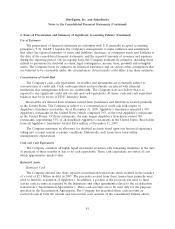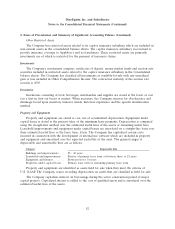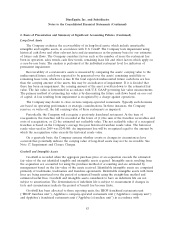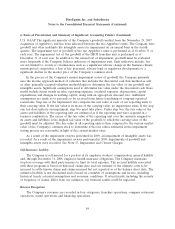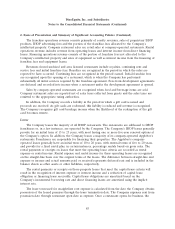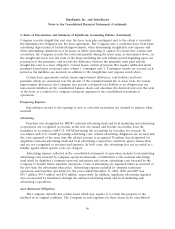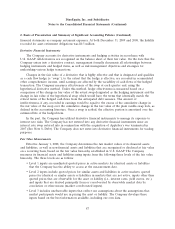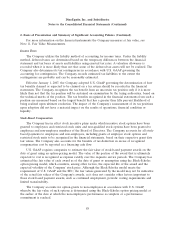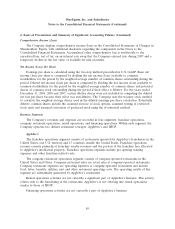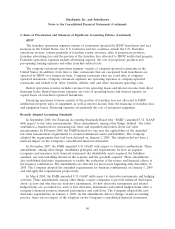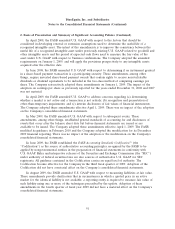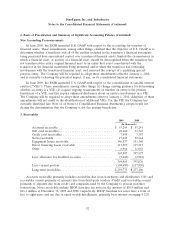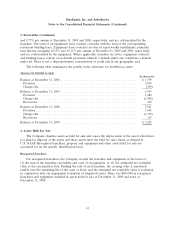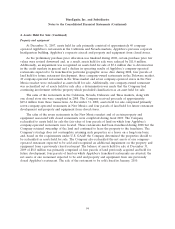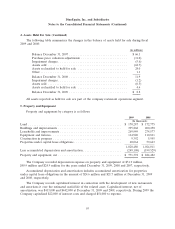IHOP 2009 Annual Report Download - page 104
Download and view the complete annual report
Please find page 104 of the 2009 IHOP annual report below. You can navigate through the pages in the report by either clicking on the pages listed below, or by using the keyword search tool below to find specific information within the annual report.DineEquity, Inc. and Subsidiaries
Notes to the Consolidated Financial Statements (Continued)
2. Basis of Presentation and Summary of Significant Accounting Policies (Continued)
The franchise operations revenue consists primarily of royalty revenues, sales of proprietary IHOP
products, IHOP advertising fees and the portion of the franchise fees allocated to the Company’s
intellectual property. Company restaurant sales are retail sales at company-operated restaurants. Rental
operations revenue includes revenue from operating leases and interest income from direct financing
leases. Financing operations revenue consists of the portion of franchise fees not allocated to the
Company’s intellectual property and sales of equipment as well as interest income from the financing of
franchise fees and equipment leases.
Revenues from franchised and area licensed restaurants include royalties, continuing rent and
service fees and initial franchise fees. Royalties are recognized in the period in which the sales are
reported to have occurred. Continuing fees are recognized in the period earned. Initial franchise fees
are recognized upon the opening of a restaurant, which is when the Company has performed
substantially all initial services required by the franchise agreement. Fees from development agreements
are deferred and recorded into income when a restaurant under the development agreement is opened.
Sales by company-operated restaurants are recognized when food and beverage items are sold.
Company restaurant sales are reported net of sales taxes collected from guests and the sales taxes are
remitted to the appropriate taxing authorities.
In addition, the Company records a liability in the period in which a gift card is issued and
proceeds are received. As gift cards are redeemed, this liability is reduced and revenue is recognized.
The Company recognizes gift card breakage income when the likelihood of the redemption of the gift
card becomes remote.
Leases
The Company leases the majority of all IHOP restaurants. The restaurants are subleased to IHOP
franchisees or, in a few instances, are operated by the Company. The Company’s IHOP leases generally
provide for an initial term of 15 to 25 years, with most having one or more five-year renewal options at
the Company’s option. In addition, the Company leases a majority of its company-operated Applebee’s
restaurants. Franchisees are responsible for financing their properties. The Applebee’s company-
operated leases generally have an initial term of 10 to 20 years, with renewal terms of five to 20 years,
and provide for a fixed rental plus, in certain instances, percentage rentals based on gross sales. The
rental payments or receipts on leases that meet the operating lease criteria are recorded as rental
expense or rental income. Rental expense and rental income for these operating leases are recognized
on the straight-line basis over the original terms of the leases. The difference between straight-line rent
expense or income and actual amounts paid or received represents deferred rent and is included in the
balance sheets as other assets or other liabilities, respectively.
The rental payments or receipts on those property leases that meet the capital lease criteria will
result in the recognition of interest expense or interest income and a reduction of capital lease
obligation or financing lease receivable. Capital lease obligations are amortized based on the
Company’s incremental borrowing rate and direct financing leases are amortized using the implicit
interest rate.
The lease term used for straight-line rent expense is calculated from the date the Company obtains
possession of the leased premises through the lease termination date. The Company expenses rent from
possession date through restaurant open date as expense. Once a restaurant opens for business, the
85


